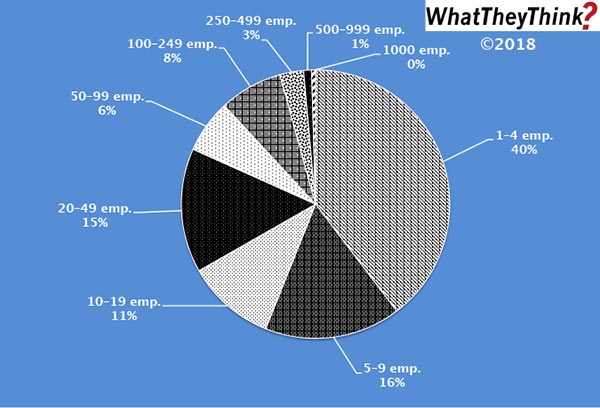
Two weeks ago, we looked at the overall trend of book printing establishments(NAICS 323117) over the course of the 2010s. This week, we look specifically at the breakdown of book printing establishments by employee size. In 2016, the most recent year for which we have data, more than one-half (56%) of book printers had fewer than 10 employees, and 40% had fewer than five. Only 15% of book printing establishments had 50 or more employees. In an upcoming Establishments Slice’n’Dice, we’ll look at this breakdown among commercial print businesses in general, but as a preview, 69% of general commercial printing establishments have fewer than 10 employees. So book printers tend to be slightly larger establishments than average.
The data in this chart is gleaned from our Commercial Printing Establishments, which complements and supplements our regular tracking of printing industry shipments and other industry data. Based on data from the Census Bureau’s County Business Patterns, we present—in spreadsheet form—U.S. commercial printing establishments from 2010 to 2016, including establishment counts for six commercial printing business classifications (based on NAICS, the North American Industrial Classification System):
- 323 (Printing and Related Support Activities)
- 32311 (Printing)
- 323111 (Commercial Printing, except Screen and Books)
- 323113 (Commercial Screen Printing)
- 323117 (Books Printing)
- 32312 (Support Activities for Printing—aka prepress and postpress services)
We further break these counts down by establishment size:
- 1–4 employees
- 5–9 employees
- 10–19 employees
- 20–49 employees
- 50–99 employees
- 100–249 employees
- 250–499 employees
- 500–999 employees
- 1000 employees
These data, and the overarching year-to-year trends, like other demographic data, can be used not only for business planning and forecasting, but also sales and marketing resource allocation.
Every other week, we will be breaking these establishment data down in different ways. Over time, we will be adding additional data from the County Business Patterns, such as number of employees, payroll, and similar information for additional business classification of relevance to the graphic communications industry.














